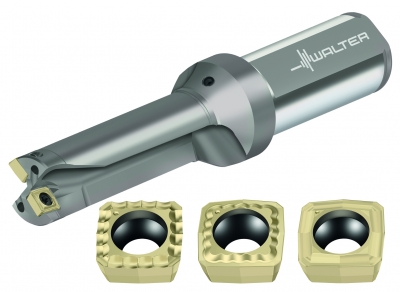
Walter has introduced the D3120, an indexable insert drill built to provide trouble-free drilling in virtually all conditions. It features square positive indexable inserts with four cutting edges, enabling it to reduce cost per cutting edge. Combined with the new Tiger-Tec® Gold PVD grade WSP45G, these new drills bring significantly higher tool life and cost savings for the user.
Available in diameter sizes ranging from 0.562-1.375 in. and 16-42 mm with 2, 3, 4 x Dc, the new drill delivers maximum process reliability with simple and efficient chip removal, two coolant channels and polished flutes. Superior protection against friction is provided by the D3120 hardened and polished surfaces. This combination of surface hardness and improved coolant flow results in reduced wear on the drill surface.
The new drill is easy to use since it has one indexable insert shape for both outer and inner seat, and a measuring collar for easy diameter identification. In addition to extension of inch sizes for the drill body, Walter has also introduced a new Tiger·tec® Gold PVD grade WSP45G for the P284 inserts. The new grade features significantly improved layer bonding, post-secondary treatment and Al2O3 crystal orientation leading to a vast improvement in tool life. The grade can be used universally for ISO material groups P (steels), M (stainless steels) and S (super alloys). The Tiger·tec® Silver grades WKP25S and WKP35S are also available for ISO material groups P (steels), M (stainless steels) K (cast irons), N (nonferrous) and S (super alloys). Additionally, WK10 grade for aluminums and WXP40, primarily for central inserts are also available. Torx Plus screws give it secure indexable insert clamping and high stability in all working conditions.
Contact Details
Related Glossary Terms
- coolant
coolant
Fluid that reduces temperature buildup at the tool/workpiece interface during machining. Normally takes the form of a liquid such as soluble or chemical mixtures (semisynthetic, synthetic) but can be pressurized air or other gas. Because of water’s ability to absorb great quantities of heat, it is widely used as a coolant and vehicle for various cutting compounds, with the water-to-compound ratio varying with the machining task. See cutting fluid; semisynthetic cutting fluid; soluble-oil cutting fluid; synthetic cutting fluid.
- flutes
flutes
Grooves and spaces in the body of a tool that permit chip removal from, and cutting-fluid application to, the point of cut.
- hardness
hardness
Hardness is a measure of the resistance of a material to surface indentation or abrasion. There is no absolute scale for hardness. In order to express hardness quantitatively, each type of test has its own scale, which defines hardness. Indentation hardness obtained through static methods is measured by Brinell, Rockwell, Vickers and Knoop tests. Hardness without indentation is measured by a dynamic method, known as the Scleroscope test.
- indexable insert
indexable insert
Replaceable tool that clamps into a tool body, drill, mill or other cutter body designed to accommodate inserts. Most inserts are made of cemented carbide. Often they are coated with a hard material. Other insert materials are ceramic, cermet, polycrystalline cubic boron nitride and polycrystalline diamond. The insert is used until dull, then indexed, or turned, to expose a fresh cutting edge. When the entire insert is dull, it is usually discarded. Some inserts can be resharpened.
- physical vapor deposition ( PVD)
physical vapor deposition ( PVD)
Tool-coating process performed at low temperature (500° C), compared to chemical vapor deposition (1,000° C). Employs electric field to generate necessary heat for depositing coating on a tool’s surface. See CVD, chemical vapor deposition.








